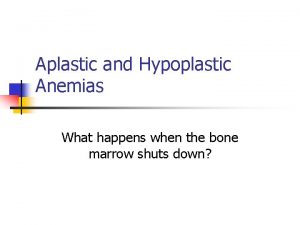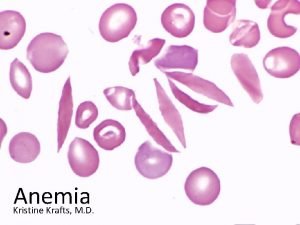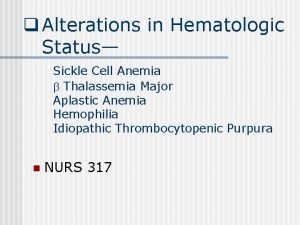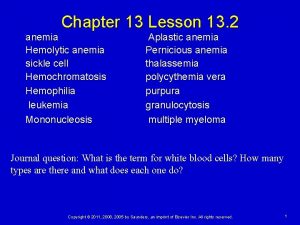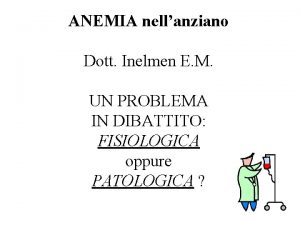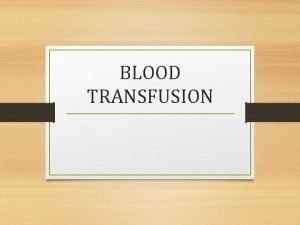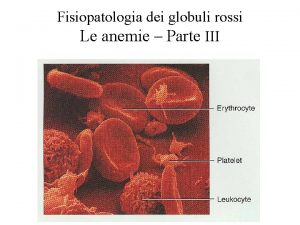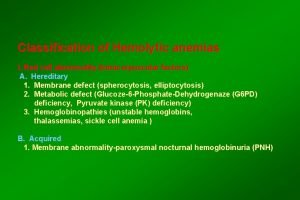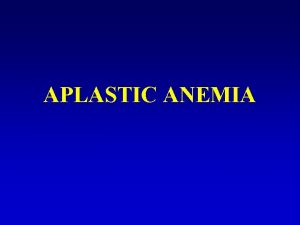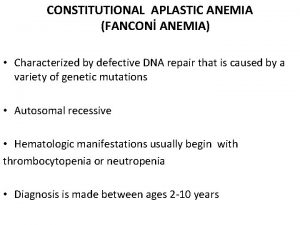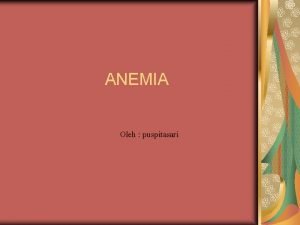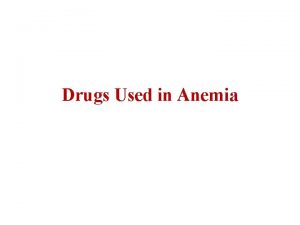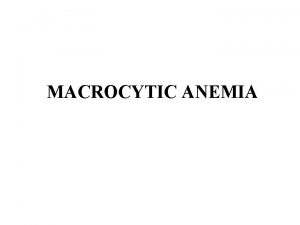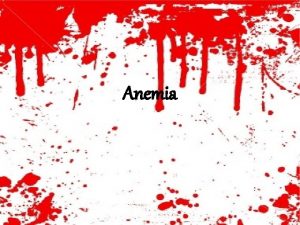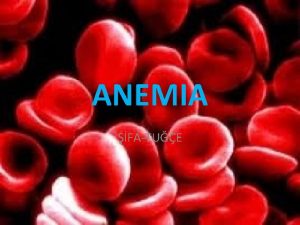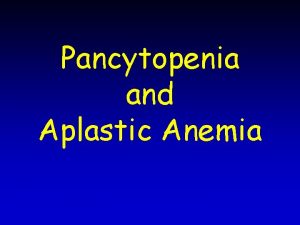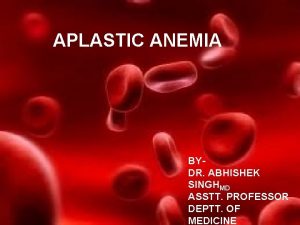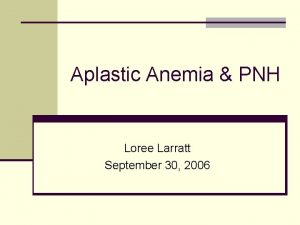APLASTIC ANEMIA APLASTIC ANEMIA Aplastic anemia is a
















- Slides: 16

APLASTIC ANEMIA

APLASTIC ANEMIA Aplastic anemia is a severe, life threatening syndrome in which production of erythrocytes, WBCs, and platelets has failed. Aplastic anemia may occur in all age groups and both genders. The disease is characterized by peripheral pancytopenia and accompanied by a hypo cellular bone marrow.

APLASTIC ANEMIA Pathophysiology: The primary defect is a reduction in or depletion of hematopoietic precursor stem cells with decreased production of all cell lines. This is what leads to the peripheral pancytopenia. This may be due to quantitative or qualitative damage to the pluripotential stem cell. In rare instances it is the result of abnormal hormonal stimulation of stem cell proliferation or the result of a defective bone marrow microenvironment or from cellular or humoral immunosuppression of hematopoiesis.

PATHOPHYSIOLOGY OFAPLASTIC ANEMIA

APLASTIC ANEMIA Etiology Acquired Most cases of aplastic anemia are idiopathic and there is no history of exposure to substances known to be causative agents of the disease Exposure to ionizing radiation – hematopoietic cells are especially susceptible to ionizing radiation. Whole body radiation of 300 -500 rads can completely wipe out the bone marrow. With sublethal doses, the bone marrow eventually recovers. Chemical agents – include chemical agents with a benzene ring, chemotherapeutic agents, and certain insecticides. Idiosyncratic reactions to some commonly used drugs such as chloramphenicol.

APLASTIC ANEMIA Infections – viral and bacterial infections such as infectious mononucleosis, infectious hepatitis, cytomegalovirus infections, and miliary tuberculosis occasionally lead to aplastic anemia Pregnancy (rare) Paroxysmal nocturnal hemoglobinuria – this is a stem cell disease in which the membranes of RBCs, WBCs and platlets have an abnormality making them susceptible to complement mediated lysis. Other diseases – carcinoma

APLASTIC ANEMIA Congenital disorders Fanconi’s anemia – the disorder usually becomes symptomatic ~ 5 years of age and is associated with progressive bone marrow hypoplasia. Congenital defects such as skin hyperpigmentation and small stature also seen in affected individuals. Familial aplastic anemia – a subset of Fanconi’s anemia in which the congenital defects are absent. Clinical manifestations Progressive weakness and Fatigue Heart palpitations Pallor Infections Petechiae and ecchymosis Mucosal bleeding, bleeding from gut or hematuria Neurological deficits suggest intracranial bleed due to thrombocytopenia Liver and spleen not enlarged.

APLASTIC ANEMIA Lab findings Severe pancytopenia with relative lymphocytosis (lymphocytes live a long time) Normochromic, normocytic RBCs (may be slightly macrocytic) Mild to moderate anisocytosis and poikilocytosis Decreased reticulocyte count Hypocellular bone marrow with > 70% yellow marrow Treatment – in untreated cases the prognosis is poor Remove causative agent, if known Multiple transfusions Bone marrow transplant

MANAGEMENT OF SEVERE APLASTIC ANEMIA 1. Hematopoietic stem cell transplantation 2. Immunosuppressive treatment - cyclosporine - antilymphocyte/antityhymocyte globulin, - methylprednisolone - growth factors (G-CSF) 3. Androgens 4. Supportive therapy 5. Growth factors (GM-CSF, G-CSF, EPO)

HEMATOPOIETIC STEM CELL TRANSPLATATION IN SEVERE APLASTIC ANEMIA 1. Advantages - correction of hematopoietic defect - long-term survival: 80% - 90% (HLA-matched sibling donor) - majority of the patients appear to be cured 2. Restrictions - age below 40 - suitable donor available in less than 30% (sibling) - 5 -15% risk of graft failure in multitransfused patients - high mortality - solid tumors (12%)

RESULTS OF COMBINED IMMUNOSUPPRESSIVE THERAPY IN SEVERE APLASTIC ANEMIA 1. Antilymphocyte/antithymocyte globulin with androgens 43% 2. Cyclosporine androgens 45% 3. Antilymphocyte/antithymocyte globulin and methylprednisolone 47% 4. Antilymphocyte/antithymocyte globulin, methylprednisolone and cyclosporine A 60 -70%

COMPLICATION OF IMMUNOSUPPRESSIVE THERAPY 1. Failure of therapy and relapse of AA a) b) c) d) 2. exhaustion of stem cell reserves insufficient immunosuppression misdiagnosis hereditary bone marrow failure (non-immune pathogenesis) Hematopoietic clonal disease a) b) c) acute myelogenous leukemia myelodysplastic syndrom paroxysmal noctutnal hemoglobinria

NOVEL AGENTS IN TREATMENT OF AA (IMMUNOSUPPRESIVE, IMMUNOMODULATORS) 1. 2. 3. 4. 5. Mycofenolate mofetil Anti-Il-2 receptor monoclonal antibody Anti CD 52 monoclonal antibody Rapamycin Anti-TNF alfa monoclonal antibody

THERAPY OF NON-SEVERE APLASTIC ANEMIA 1. „Watch and wait” 2. Androgens (? ) 3. Supportive care: blood and platelet transfusion, antibiotics, growth factors 4. Immunosuppressive treatment in selected patients

ANDROGENS IN THE TREATMENT OF AA 1. Severe aplastic anemia - no effect when applied as a single agent, - improve the results if in combination with antilymphocyte/antithymocyte globulin and cyclosporine 2. Non-severe aplastic anemia - effective in 20 - 30% of patients.

CAUSES OF PANCYTOPENIA 1. Failure of production of blood cells a) bone marrow infiltration - acute leukemias - hairy cell leukemia - multiple myeloma - lymphoma - myelofibrosis - metastatic carcinoma b) aplastic anemia c) vit. B 12 and folate deficiency 2. Ineffective hematopoesis - myelodysplastic syndrome 3. Increased destruction of blood cells - hipersplenism - autoimmune disorders - paroxysmal nocturnal hemoglobinuria 4. Myelosuppression after irradiation or antiproliferative drugs
 Pathophysiology of aplastic anemia
Pathophysiology of aplastic anemia Thalassemia
Thalassemia Aplastic anemia
Aplastic anemia Hod diskem historie
Hod diskem historie Aplastic crisis
Aplastic crisis Pernicious anemia vs megaloblastic anemia
Pernicious anemia vs megaloblastic anemia Investigation of megaloblastic anemia
Investigation of megaloblastic anemia Lesch nyhan syndrome
Lesch nyhan syndrome Sabrina prater
Sabrina prater Anemia ipoproliferativa
Anemia ipoproliferativa Tipos de anemia
Tipos de anemia Nurses notes for blood transfusion
Nurses notes for blood transfusion Anemia hemolitica extracorpuscular
Anemia hemolitica extracorpuscular Macrovalocitosi
Macrovalocitosi Uterine atony causes
Uterine atony causes Classification of hemolytic anemia
Classification of hemolytic anemia Prencious anemia
Prencious anemia
